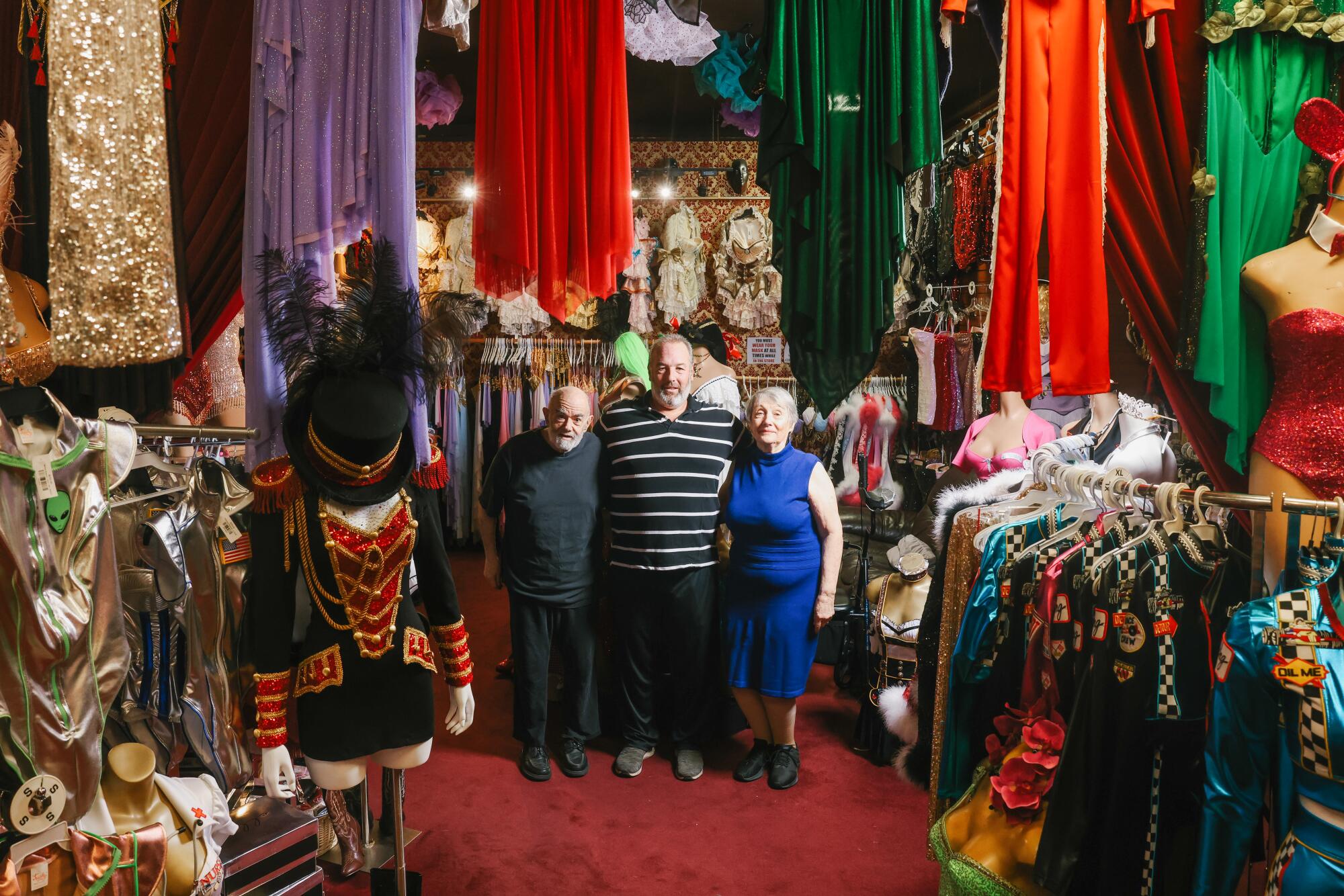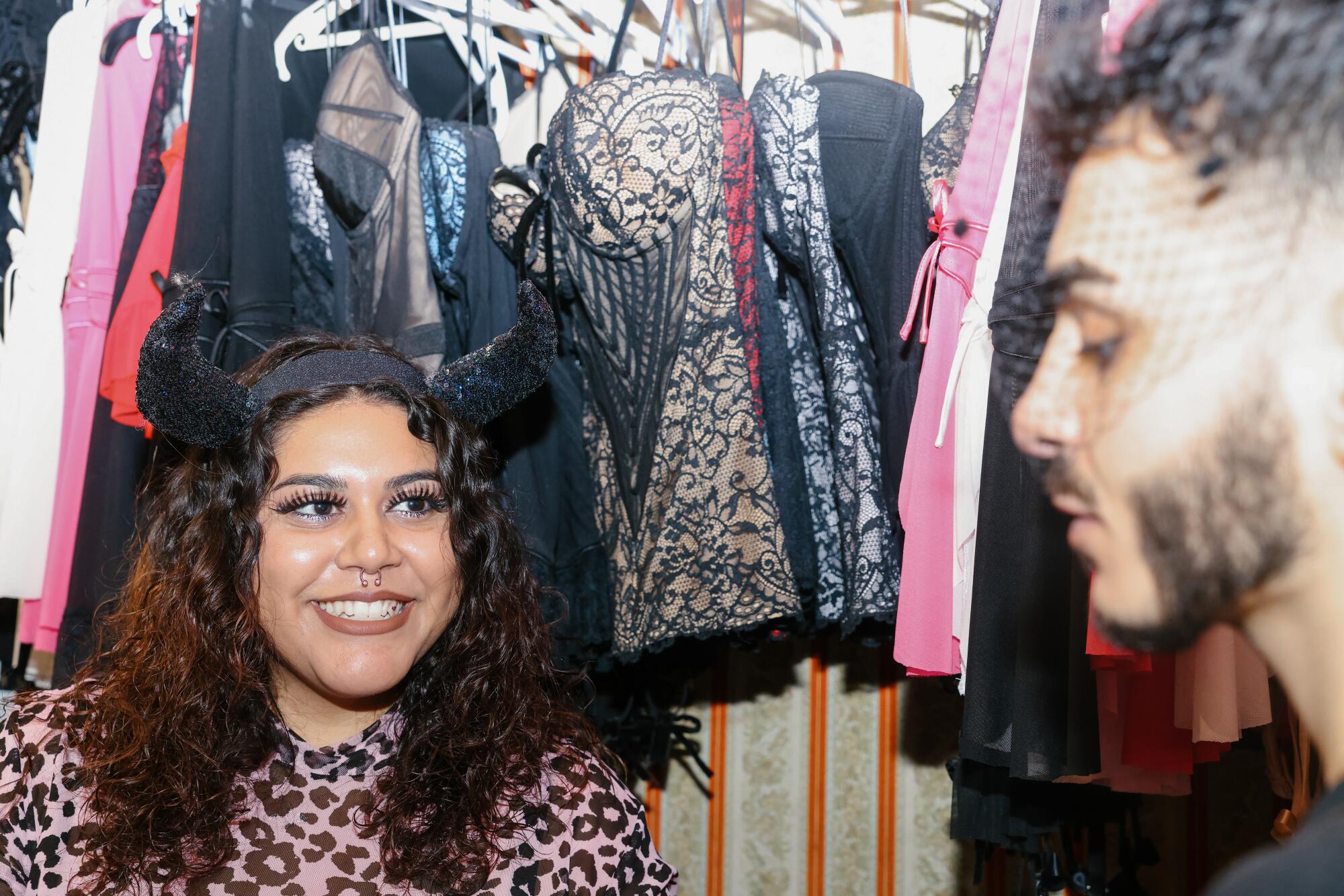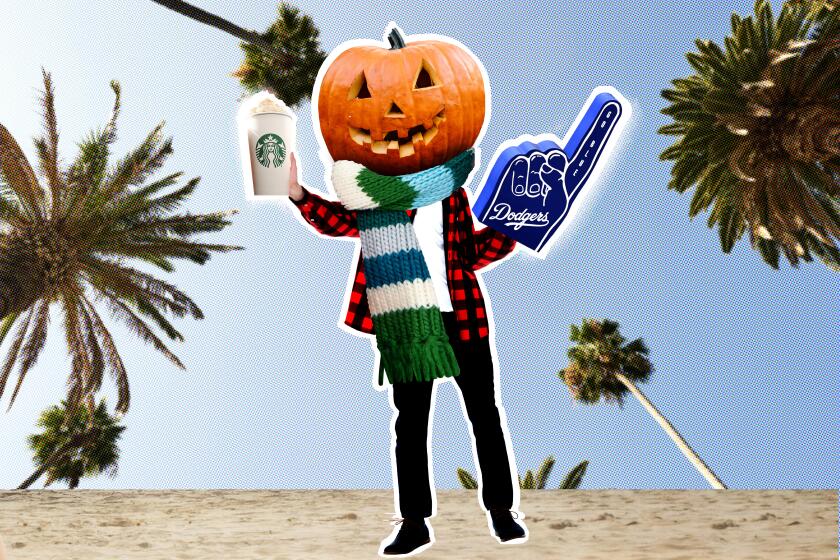
Los Angeles’ hottest private members club — with its annual fee of $2 and at times nudity — hides in plain sight on La Cienega Boulevard as the modest birthplace of Halloween’s sexy-costume-industrial complex.
You know the one.

Violent pink façade. Come-hither mannequin window display. Cheeky wooden pinup whose derriere reads, “Park in Rear.”
It’s Trashy Lingerie, the bawdy boutique that’s defined a Los Angeles aesthetic with its tailor-made lingerie and costumes and, in doing so, has seized a fierce trade loyalty. In April, Trashy will celebrate 50 years at its original location, owned and run by the same family, with its goods designed and handmade in-house since the beginning. Thanks to social media, a new crop of Halloween shoppers, like fast-fashion-averse Zoomers, are driving sales.
“There’s a special feeling when you walk in there,” said model-actress Carmen Electra. “You feel like, ‘Wow, this is Hollywood,’ you know?”
She was an aspiring singer and dancer and new to Los Angeles in the early ’90s. Prince, her then-mentor, had his bodyguard take her shopping. They went to Trashy but didn’t know about the members-only policy, which is a formality to make shoppers feel more comfortable. She filled out a one-page application and paid the price of admission. It became her favorite store. She’s lost count of the times she’s enlisted Trashy onstage, during photo shoots and on movie sets, but she still has every costume.
“I remember being in the dressing room and Paris Hilton or Kim Kardashian would be in the other,” Electra said. “Or you’d walk out and Courtney Love is leaving out the back with a huge bag, and that’s just how Trashy Lingerie is.”
These Los Angeles-based stores, museums, and galleries celebrate Halloween year-round with spooky antiques, oddities, costumes, horror decor, and more.

The store has built its reputation on its high-quality, original products with rigorous customer service to match, making it a haven not just for VIPs but also for wardrobe stylists and costume designers. Trashy has made some of pop culture’s most iconic looks, like the bunny suits for Reese Witherspoon in “Legally Blonde” and Renée Zellweger in “Bridget Jones’s Diary.” The store also has made looks for Pamela Anderson in “Barb Wire,” Emma Stone in “Easy A” and the Fembots in “Austin Powers,” as well as Madonna, Cher, Stevie Nicks, Ariana Grande and Teyana Taylor.
Shopping (or window shopping) for Halloween at Trashy is a rite of passage for many Angelenos. October can account for 60% of the year’s sales, with the majority coming in the 10 days leading up to the holiday.
Trashy’s price point is summed up in one phrase: “If you know, you know,” said Randy Shrier, who runs the store these days. “And if you have to ask why it’s this price after trying it on, then you’ll never know.” In other words, it costs a lot of money to look this trashy, to paraphrase another longtime customer, Dolly Parton.
Popular ready-to-wear getups like flappers, cowgirls, fairies and nurses can range from $250 to $1,500; the elaborate three-piece Marie Antoinette dress, a pièce de résistance made of brocade silk dripping with pearls and satin bows, costs $1,315. Custom Halloween costumes can fetch up to $4,000 and have to be ordered by July.
The beginning of the ‘sexy Halloween industry’
“The sexy Halloween industry was based on all our stuff,” said Shrier, who took over after his parents retired. Mitchell and Tracy Shrier opened the storefront in 1973 as a shoe shop. They named it after one of Mitchell’s slingback designs, “the Trashy,” which was taken from a British slang term to mean fashionable or tart.
Mitchell chose the location for two reasons: It was already a former shoe store, and the block had built-in foot traffic. A year in and the Shriers started fielding requests for hosiery to go with heels, so they hand-dyed stockings in vivid colorways.

“When I was a little kid, our whole backyard was filled with nylon stockings blowing in the breeze in all the colors of a rainbow,” Shrier recalled. Customers needed garter belts to hold up the stockings, so they made those too, working their way up the body with underwear and bras until they had an entire lingerie line. By 1979, they had gotten rid of the shoe rack and taken over next door. They maintained a leg up by sticking with one location, paying skilled workers competitive wages and adapting to six generations of customers.
With its good weather, showbiz bodies and bikini beaches, post-sexual revolution L.A. was the natural hotbed of the underwear-as-outerwear trend. A Trashy bustier worn by Madonna on her 1987 Who’s That Girl world tour sold for a record $72,000 in 2011. Playboy and Penthouse used Trashy’s products for centerfold shoots, while the Runaways wore Trashy onstage, and the Go-Go’s featured the store in the music video for “Our Lips Are Sealed.”


From heat-map red to Dodger blue, L.A.’s autumnal colors are there if you just know where to look.
Then came the ’90s and breast implants, another place for Trashy’s assets to shine. Until the company went online in 1998, it was Tinseltown’s best-kept secret. Paris Hilton has been shopping at the store since she was 15. By the early 2000s, reality TV and a relentless paparazzi culture had introduced the world to Trashy.
Shrier said the store was like a clubhouse at the time, especially for Playmates, who ran around the store naked in search of outfits for Halloween or Playboy’s annual Midsummer Night’s Dream party. On E!’s “The Girls Next Door,” Hugh Hefner’s three girlfriends regularly designed bespoke ensembles at Trashy, but Bridget Marquardt was their resident Halloweenist. A few months ago she bought a custom gown to host in her new Elvira-style show, “Bridget’s Hollywood Horror Night.” “They just really know how to form the female body,” she said.

Trashy is iconic (and so are its corsets)
The corset is the backbone of the Shriers’ 10,000-square-foot operation; it remains their bestseller, specialty and signature look. “A corset will always sell a costume,” Shrier said. Once a symbol of constraint, the garment today harnesses a subversive statement. When Caitlyn Jenner debuted her new gender identity on the 2015 cover of Vanity Fair, she did it wearing Trashy’s 36D “Edy” corset.
Corset-making requires technical perfection. A six-panel waist and three-paneled cups have to do two things at once: suck you in while lifting you up. It has to be livable, but also not too livable.
“It’s like trying to keep two dogs in a bathtub,” said Penelope Gibbs, fashion designer and Trashy’s newest hire. She works side by side with Mitchell Shrier at his and Tracy’s house, a block from the store.
Working with Gibbs has “definitely saved my life, gives me something to do every day,” said Mitchell, who retired two years ago due to health concerns. He’s 85 and lives with an oxygen tank; she’s 21 and graduated last year from the Fashion Institute of Design & Merchandising. They learn from each other every day while collaborating on Trashy’s upcoming collection.

Social media is reviving Trashy’s heyday and introducing Gen Z to the brand. “This was yall????? Iconic af,” goes a typical comment about pop culture costumes. But it also has resurrected outdated costumes that relied on racist stereotypes, especially those of oppressed groups. Native American attire was still on the website under “Wild West until this month. The Shriers said they don’t make or sell these costumes anymore.
Potentially problematic costumes aren’t worth making to appeal to some customers when it would exclude or hurt others, Gibbs said.
“It shows the adaptation of Trashy,” Gibbs said. “Even with something you can’t anticipate — not just a different trend but a different world.”
From Flamingo Estate mud bath to Black Girl Sunscreen to Ranavat Fortifying Hair Serum, elevation is the name of the game this season.
Trashy has expanded and contracted over its five decades, but today it resembles the leaner early years. For Randy Shrier, who first started working in the shop at age 16, it’s a new era marked by less stress. He was able to get rid of legacy debt thanks to a quick pivot to mask-making in the early days of the COVID-19 pandemic, a loan from the Paycheck Protection Program and the federal employee retention credit program.
“Something surprising is happening this year. We’re getting a whole new crowd of young people.”
— Mitchell Shrier
“Ever since I was a kid, we’ve always had debt,” he said. “It’s the first time where this company has not had that.” Last year was Trashy’s most profitable Halloween season on record.


“Something surprising is happening this year,” Mitchell Shrier said. “We’re getting a whole new crowd of young people.”
Jake DuPree had lived and worked in L.A. for 11 years as a burlesque dancer, but until they came out as nonbinary in 2020, visiting Trashy Lingerie had remained an unfulfilled fantasy.
“I expected it to be catered to these like skinny, blond, white women, to be honest,” they said of the beauty ideals that dominated Y2K fashion. Instead, they found a solicitous staff ready to make them feel good and have fun, DuPree said, an experience that stood for reclamation and empowerment. They bought a bunny outfit in black stretch satin, a bedazzled red one and a sexy Dorothy costume.
“It was the first time I allowed myself to accept myself and to be the full version of me,” DuPree said. “Those outfits mean a lot to me in that way.”
More to Read
Sign up for The Wild
We’ll help you find the best places to hike, bike and run, as well as the perfect silent spots for meditation and yoga.
You may occasionally receive promotional content from the Los Angeles Times.













